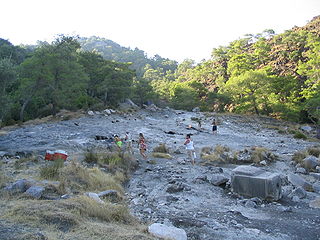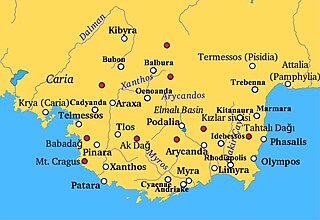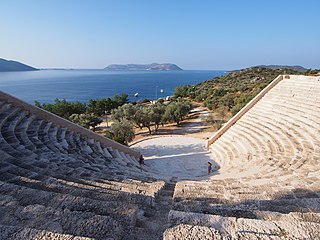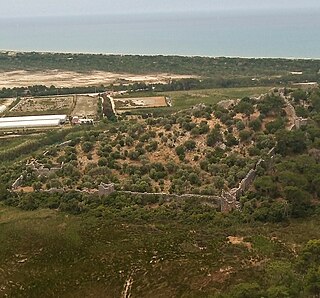Related Research Articles

Thomas Abel Brimage Spratt was an English vice-admiral, hydrographer, and geologist.

Mount Chimaera was the name of a place in ancient Lycia, notable for constantly burning fires. It is thought to be the area called Yanartaş in Turkey, where methane and other gases emerge from the rock and burn. Some ancient sources considered it to be the origin of the myth of the monster called the Chimera, because of similarities described below.

Mount Cragus or Mount Cragos or Mount Kragos – also recorded as Hiera Acra – is a mountain in Turkey, in what was formerly ancient Lycia, Asia Minor. It is identified with the modern Sandak Dağ.

Araxa was a city of ancient Lycia, according to Alexander Polyhistor, in the second book of his Lyciaca. Ptolemy places it near Sidyma. It is located at place called Ören, near Fethiye, on the upper portion of the Xanthus River.

Babadağ is a mountain near Fethiye, in Muğla Province, southwest Turkey.
Kandyba or Candyba was a settlement in ancient Lycia, in modern-day Antalya province on the southwestern Mediterranean coast of Turkey.

Cadyanda or Kadyanda was a town of ancient Lycia. The site was discovered by Charles Fellows. The decree of Pixodarus now in the British Museum shows that the Lycian name of the town was Xadawãti.
Daedala or Daidala was a city of the Rhodian Peraea in ancient Caria, or a small place, as Stephanus of Byzantium says, on the authority of Strabo.

Antiphellus or Antiphellos, also known to the ancients as Habessus, was a settlement that acted as the Lycian port of Phellus, now in modern Turkey. The ruins at Antiphellus include hillside tombs, a well-preserved Hellenistic theatre overlooking the sea, and a sarcophagus.

Phellus is a town of ancient Lycia, now situated on the mountainous outskirts of the small town of Kaş in the Antalya Province of Turkey. The city was first referenced as early as 7 BC by Greek geographer and philosopher Strabo in Book XII of his Geographica, alongside the port town of Antiphellus; which served as the settlement's main trade front.
Carmylessus or Karmylessos was a town of ancient Lycia, described by Strabo between Telmissus and the mouth of the Xanthus. After Telmissus, he says, then Anticragus, an abrupt mountain on which is the small place Carmylessus, lying in a ravine.
Thomas Graves was an officer of the Royal Navy and naturalist who worked extensively as a surveyor in the Mediterranean.

Bubon or Boubon was a city of ancient Lycia noted by Stephanus of Byzantium; the ethnic name, he adds, ought to be Βουβώνιος, but it is Βουβωνεύς, for the Lycians rejoice in this form. The truth of this observation of Stephanus is proved by the inscription found on the spot: Βουβωνέων ἡ Βουλὴ καὶ ὁ Δῆμος.

Cyaneae, also spelled Kyaneai or Cyanae, was a town of ancient Lycia, or perhaps three towns known collectively by the name. Leake observes that in some copies of Pliny it is written Cyane; in Hierocles and the Notitiae Episcopatuum it is Cyaneae.
Corydala or Corydalla or Korydalla or Korydala was a city of ancient Lycia. Anciently, it belonged to the Rhodians, according to Hecataeus, quoted by Stephanus. But it was not in Rhodes, nor was it one of the Rhodian possessions in the Peraea, Caria. The Tabula Peutingeriana marks Corydala on the road from Phaselis to Patara, and makes the distance between these two places 29 Roman miles Pliny places Corydalla in the interior of Lycia, and Ptolemy mentions it with Sagalassus, Rhodia, Phellus, Myra, and other places, as about Mons Massicytus.

Nisa, also Nyssa (Νύσσα) or Nysa (Νύσα) or Neisa (Νείσα), was a town in ancient Lycia near the source of the River Xanthus.

Isinda was a town of ancient Pisidia.
Lissa was a town of ancient Lycia, mentioned by Ptolemy.

Pydnae or Kydna is the site of an abandoned Hellenistic town on the coast of ancient Lycia in Asiatic Turkey between the River Xanthus and Cape Hieron.
Trysa or Tryssa was a town of ancient Lycia, located between Cyaneae and Myra. It has been archaeologically examined, and among the finds are Lycian tombs, most notably the Heroon of Trysa. Greek inscriptions which were found there show that there was a cult of Zeus Eleutherios and of Helios at Trysa. The town was also inhabited during the Byzantine period and there was a church on the acropolis.
References
- ↑ Gustav Hirschfeld : Arsada.(in German) In: Realencyclopädie der classischen Altertumswissenschaft (RE). Vol. II,1, Stuttgart 1895, col. 1267.
- ↑ Richard Talbert, ed. (2000). Barrington Atlas of the Greek and Roman World . Princeton University Press. p. 65, and directory notes accompanying.
- ↑ Lund University. Digital Atlas of the Roman Empire.
- ↑ Thomas Abel Brimage Spratt, Travels in Lycia, & Important papers in the Journals of the Geological & Geographical Societies (1847), vol. ii. p. 291.
![]() This article incorporates text from a publication now in the public domain : Smith, William, ed. (1854–1857). "Arsada". Dictionary of Greek and Roman Geography . London: John Murray.
This article incorporates text from a publication now in the public domain : Smith, William, ed. (1854–1857). "Arsada". Dictionary of Greek and Roman Geography . London: John Murray.